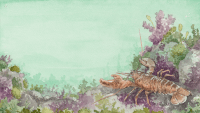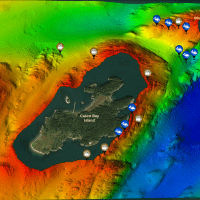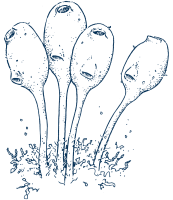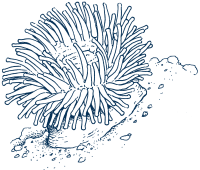
Casco Bay Island
Dive DeeperStrong tides funnel through Head Harbour Passage. These sweep the steep and rocky underwater walls of Casco Bay Island. This flow of water provides abundant food for the bright anemones, massive sponges, and translucent sea vases. Gigantic lobster range over the seabed in search of prey. Where the water becomes deeper. forests of long-stemmed sea potatoes cloak the rocky floor. In shallow water, scientists SCUBA dive to monitor the seabed life with photographic transects. This isn’t possible in deeper water, so here they have to use more complex drop camera systems.
Explore the Seafloor
Come for a dive at Casco Bay Island! Take a virtual swim along the seabed using our interactive 3D map. The seabed has been mapped using sound waves (sonar). Let images and videos introduce you to some of the amazing species that live here. Once you're back on the surface, learn about the camera and video technology that helps us study the seabed.


American Lobster
Homarus americanus
Lobsters are nocturnal and in the daytime are usually found hiding in crevices in bedrock and between boulders. At night they venture out in search of their prey. They mainly eat molluscs (especially mussels), sea stars, urchins, and worms. They use their heavier claw for crushing prey and the narrower claw for tearing or cutting food. Like us, lobsters can be left or right handed - the heavier claw can be on either side. American lobsters can reach a body length of 64 centimetres and a weight of over 20 kilograms. This makes them the heaviest living arthropod species.

Sea Potato
Boltenia ovifera
Sea potatoes are actually stalked sea squirts. Despite their simple appearance, sea squirts are a close relative to humans. We are in the same animal group: phylum Chordata. Chordates have a dorsal hollow nerve cord (spinal cord) and a notochord at some stage of development. The tadpole-like larva of the sea potato has these, but absorbs them when it settles on the seabed to become an adult. Dense forests of sea potatoes grow in high current areas. They feed on small particles in the water and the currents transport their food to them. Numbers have declined significantly in the Bay of Fundy in recent years. Dragging for bottom fish can damage sea potatoes.

Northern Red Anemone
Urticina sp.
This large anemone can be up to 20 centimetres in diameter and scientists think they can live for over 50 years. They attach onto rocks and shells. They catch food using their tentacles, which are heavily armoured with stinging cells (nematocysts). They prey on crabs, shrimps, molluscs, urchins, and small fish. Around 77% of northern red anemone larvae are chimeric. This is where two embryos have fused to form one individual "megalarvae." Scientists think that the super-anemones formed from these megalarvae might be better able to defend themselves or grow faster. The extra genes may help them cope with changing environments.
360 Video
A SCUBA diver explores the marine life living on a bedrock wall at Casco Bay Island.

Click and drag to move the camera around.
Video description: The SCUBA diver descends down the wall. We hear their inhalations and the soft tinkle of bubbles as they exhale. The wall is covered with huge sponges and lamp shells. A large lobster creeps over the rocky seabed. It wheels and attacks the diver with its massive claws. It clambers over the jagged rocks, passing green sea urchins, sea vases, and sea potatoes. Eventually the lobster disappears into the distance.
Marine Career
Benthic Ecologist
Peter Lawton is a Research Scientist with Fisheries and Oceans Canada. He studies and maps the species that live on the seabed. He uses SCUBA diving and surface-deployed camera systems to study shallow coastal waters. He also participates on offshore missions to explore areas in the deep-sea that have never been surveyed before.
Learn moreTechnology
Underwater Cameras
Peter Lawton's research aims to document the presence and abundance of species on the seabed. He sees if species presence can be linked to particular features such as seabed type or near-seabed current strength. He then uses this to predict where we might find particular species. He uses many different camera and video systems, some operated by him while SCUBA diving, others operated remotely from the surface.
Learn more
